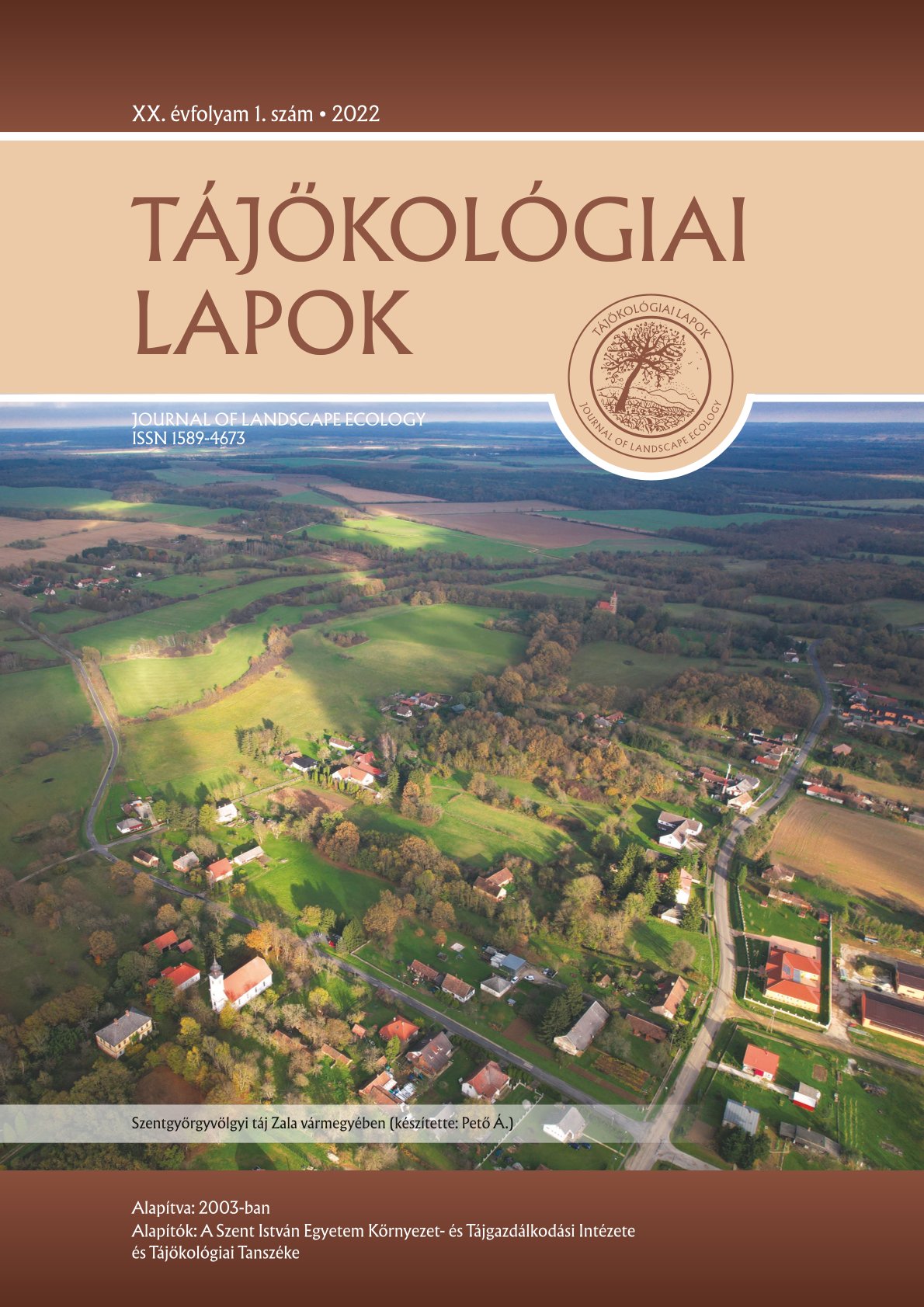Developing the methodology of HRAMS on MT Sas-hegy
DOI:
https://doi.org/10.56617/tl.3382Keywords:
nature conservation, high spatial resolution aerial remote sensing, landscape protection, habitatAbstract
The High Resolution Aerial Monitoring System (HRAMS) sets up a database based on extremely high-resolution (0,5-5 cm) remote aerial sensing surveys and field studies, therefore reveals the state of representative spots typical to the landscape. It can provide useful information in case of solving problems in fields of environmental protection and natural conservation by linking vegetation, habitat and biodiversity monitoring networks at continent and state levels. Our research discusses the development of the methodology by setting up automatized steps in land cover mapping, which reduce the time required by the process. In this way vegetation mapping becomes more efficient, which enables us to spread the network to larger areas. The limits of the method were also studied, including those land cover categories and associations that cannot be detected properly without field studies. Developments were carried out on the nature reserve of Mt Sas-hegy. In the course of our research, we created its land cover, habitat and vegetation maps, and studied its naturalness.
References
Bakó G. 2019a: Nagy terepi felbontású és frekvenciájú légi felmérésen alapuló monitoring-hálózat kiépítési módszertana. Tájökológiai Lapok 17(1): 63–78.
Bakó G. 2019b: Új eljárás a természetvédelem eszköztárában: Repülőgépes megfigyelőhálózat. Élet és Tudomány 74(8): 242–244.
Bakó G., Tolnai M., Takács Á. 2014: Introduction and testing of a monitoring and colony-mapping method for waterbird populations that uses high-speed and ultra-detailed aerial remote sensing. Sensors 14(7): 12828–12846. DOI: https://doi.org/10.3390/s140712828
Belényesi M., Burai P., Czimber K., Király G., Kristóf D., Tanács E. 2013: Távérzékelési adatok és módszerek erdőtérképezési célú felhasználása. An Augur Kft., Budapest. p. 96.
Bölöni J., Molnár Zs., Kun A. (szerk.) 2011: Magyarország élőhelyei. Vegetációtípusok leírása és határozója. ÁNÉR 2011. MTA ÖBKI, Vácrátót. pp. 145–161.
Cortés, H., Moltzan, B. (eds.) 2017: National reports of forest insect and disease conditions in the United States 2017. p. 29.
Fisher J.R.B., Acosta E.A., Dennedy‐Frank P.J., Kroeger T., Boucher T.M. 2018: Impact of satellite imagery spatial resolution on land use classification accuracy and modeled water quality. Remote Sensing in Ecology and Conservation 4: 137–149. DOI: https://doi.org/10.1002/rse2.61
Koch B. 2015: Remote sensing supporting national forest assessments. Department of Remote Sensing and Landscape Information Systems, Faculty of Forest and Environmental Sciences, Albert-Ludwigs University of Freiburg. In: Knowledge reference for national forest assessments. Food and Agriculture Organization of the United Nations, Rome. pp. 81–82.
Molnár Zs., Góber E. 2020: Repülőgépes adatgyűjtés a fenntartható jövőért. Természettudományi közlöny. 2020. február: 66–69.
Murariu, G., Hahuie, V., Murariu, A., Georgescu, L., Iticescu, C., Calin, M., Preda, C., Buruiana, D., Carp, G.B. 2017: Forest monitoring method using combinations of satellite and UAV aerial images. Case study – Bălăbăneşti forest. International Journal of Conservation Science 8: 703–714.
Shapiro, L.G., Stockman, G.C. 2001: Computer Vision. Prentice Hall Inc., Upper Saddle River, New Jersey. p. 580.
Takács G., Molnár Zs. (szerk.) 2007: Nemzeti biodiverzitás-monitorozó rendszer XI. Élőhely-térképezés, Második átdolgozott kiadás, MTA ÖBKI, KvVM, Vácrátót. pp. 23–24.
Tóth Z., Illyés Z. 2012: A budai Sas-hegy vegetációtérképezése. In: Kézdy P., Tóth Z. (szerk.): Természetvédelem és kutatás a budai Sas-hegyen. Tanulmánygyűjtemény. Rosalia 8: 225–245.
Tóth Z., Papp. L. 2012: A budai Sas-hegy edényes flórája. In: Kézdy P., Tóth Z. (szerk.): Természetvédelem és kutatás a budai Sas-hegyen. Tanulmánygyűjtemény. Rosalia 8: 189–224.
http 1: https://www.interspect.hu/NRMH.html, megtekintés: 2021.05.13.
Downloads
Published
Issue
Section
License
Copyright (c) 2022 Pácsonyi Diána, Bakó Gábor

This work is licensed under a Creative Commons Attribution-NonCommercial-NoDerivatives 4.0 International License.
A folyóirat Open Access (Gold). Cikkeire a Creative Commons 4.0 standard licenc alábbi típusa vonatkozik: CC-BY-NC-ND-4.0. Ennek értelmében a mű szabadon másolható, terjeszthető, bemutatható és előadható, azonban nem használható fel kereskedelmi célokra (NC), továbbá nem módosítható és nem készíthető belőle átdolgozás, származékos mű (ND). A licenc alapján a szerző vagy a jogosult által meghatározott módon fel kell tüntetni a szerző nevét és a szerzői mű címét (BY).












